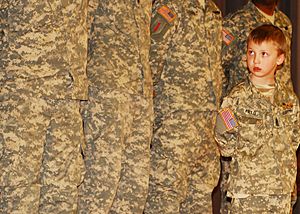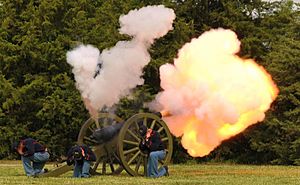Fort Riley facts for kids
Quick facts for kids Fort Riley |
|
|---|---|
| Riley / Geary counties, near Junction City, Kansas | |

Shoulder sleeve insignia of First Infantry Division
|
|
| Type | Army post |
| Site information | |
| Controlled by | United States |
| Site history | |
| Built | January, 1853 |
| In use | 1853–present |

Fort Riley is a big United States Army base in Kansas. It's located between the cities of Junction City and Manhattan, right by the Kansas River. The base is huge, covering over 100,000 acres (about 41,000 hectares)! Many soldiers and their families live and work here, with nearly 25,000 people during the day.
Contents
Why is it Called Fort Riley?
Fort Riley is named after Major General Bennet C. Riley. He was a military leader who guided the first army group along the Santa Fe Trail in 1829. The fort was built in 1853. Its main job was to protect people and trade moving along important trails like the Oregon, California, and Santa Fe trails.
After the American Civil War ended in 1865, Fort Riley became a major base for the cavalry. Cavalry soldiers rode horses. It was also a school where soldiers learned how to ride and fight on horseback. Famous leaders like George Armstrong Custer were stationed here during this time.
The Cavalry School and Famous Soldiers
In 1887, Fort Riley became the home of the United States Army Cavalry School. This is where soldiers learned to be expert horse riders and fighters.
Some of the most famous soldiers stationed here were from the all-black 9th and 10th Cavalry Regiments. These brave soldiers were known as "Buffalo Soldiers." They were at Fort Riley many times in the late 1800s and early 1900s.
During World War I, Fort Riley was a very busy place. About 50,000 soldiers were trained here! After World War II, different army divisions were based at Fort Riley. From 1970 to 1996, the famous 1st Infantry Division, also called "Big Red One," called Fort Riley home. In 2006, the "Big Red One" moved its headquarters back to Fort Riley from Germany.
Camp Whitside, a part of Fort Riley, is named after Brigadier General Samuel Whitside. He commanded a cavalry company at Fort Riley from 1871 to 1874.
Who is Stationed at Fort Riley Today?
Fort Riley is currently home to the 1st Infantry Division, also known as the "Big Red One." This division includes:
- Headquarters and Headquarters Battalion
- 1st Brigade Combat Team
- 2nd Brigade Combat Team
- 1st Infantry Division Artillery
- Combat Aviation Brigade
- 1st Infantry Division Sustainment Brigade
Other important groups at Fort Riley include:
- 97th Military Police Battalion
- 10th Air Support Operations Squadron (Air Force)
- Irwin Army Community Hospital
- 630th Ordnance Company (Explosive Ordnance Disposal)
- Department of the Army Criminal Investigation Division (CID)
Fort Riley's History
Early Days and Protection of Trails
The story of Fort Riley is closely linked to the many people who traveled west in the 1800s. These travelers used trails like the Oregon and Santa Fe trails. The United States government wanted to protect these travelers and their trade. So, they built military forts at important spots.
In 1852, a group of surveyors chose a spot where the Republican and Smoky Hill Rivers meet. This place was perfect for a fort because it was a good location to train troops to protect the trails. They called it Camp Center. In June 1853, Camp Center officially became Fort Riley.
The fort was built using local limestone. Soldiers were sent out to protect mail trains and travel routes. In 1855, more buildings were added. Sadly, a sickness called cholera broke out, and many workers died, including Captain Edmund Ogden, who was in charge of construction.
The Civil War and George A. Custer
During the American Civil War (1861-1865), regular army units left Fort Riley to fight in the war. Local militia groups then used the fort as a base. It was also used to hold Confederate prisoners for a short time.
After the Civil War, Fort Riley became important again for protecting new railroad lines being built across Kansas. In 1866, the 7th Cavalry Regiment was formed at Fort Riley. George Armstrong Custer arrived in December to lead this new regiment.
The next spring, Custer and the 7th Cavalry left Fort Riley for a campaign in western Kansas and eastern Colorado. Custer later got into trouble for leaving his post without permission to see his wife at Fort Riley.
The "Buffalo Soldiers" at Fort Riley
The 9th and 10th Cavalry Regiments, known as the "Buffalo Soldiers," were stationed at Fort Riley many times. Native Americans gave them this name because their hair reminded them of the curly hair of buffalo. These regiments were formed in 1866. They were important for training at the Cavalry School in the 1920s and 1930s.
The time between World War I and World War II was called the "golden age of the cavalry." Soldiers at Fort Riley became some of the best horse riders and fighters in the world. They even had horse shows, hunts, and polo matches! This led to the saying, "the Life of Riley," meaning a good and easy life.
However, new inventions like tanks and machine guns showed that horses might not be needed as much in future wars. By the late 1920s, the army started to develop tank forces.
World War I and Camp Funston
When America joined World War I, Fort Riley grew a lot. A large training camp called Camp Funston was built nearby in 1917. This camp could hold up to 50,000 soldiers at once! The first division to train there, the 89th, went to France in 1918.
After the war, the Cavalry School was renamed the United States Army Cavalry School. It continued to train new cavalry officers.
World War II and Training Soldiers
Before World War II, Camp Funston was rebuilt, and the 2nd Cavalry Division was stationed there in 1940. More land was added to the fort for training. During the war, about 125,000 soldiers trained at Fort Riley. Famous people like boxing champion Joe Louis and movie star Mickey Rooney trained here. President Franklin Roosevelt even visited in 1943.
After the 9th Armored Division left for war, Camp Funston was used as a camp for German prisoners of war.
The Cold War and Vietnam
After World War II, the Cavalry School closed. Fort Riley became a place to train new officers and soldiers. In 1955, the 1st Infantry Division moved to Fort Riley. New buildings and a hospital were built for the many soldiers and their families.
During the Cold War, soldiers at Fort Riley trained to be ready for any threat, especially from the Soviet Union. Events like the building of the Berlin Wall and the Cuban Missile Crisis made soldiers at Fort Riley stay on high alert.
In the mid-1960s, the 1st Infantry Division was sent to Vietnam. Fort Riley continued to train soldiers, and the 9th Infantry Division was reactivated here before also going to Vietnam. After almost five years of fighting, the 1st Infantry Division returned to Fort Riley in 1970.
The Gulf War and Beyond
In August 1990, Iraq invaded Kuwait. This led to a large deployment of U.S. troops. Fort Riley played a big part. Between November 1990 and January 1991, soldiers and equipment from Fort Riley were sent to the Persian Gulf. Over 15,000 soldiers were deployed. They fought in Operation Desert Storm, which quickly defeated the Iraqi army. The soldiers returned to Fort Riley later that spring.
After the Gulf War, the 1st Infantry Division headquarters moved to Germany in 1995. However, in 1999, Fort Riley became a Division Headquarters again with the reactivation of the 24th Infantry Division.
Since 2003, Fort Riley units have supported combat operations in Iraq and Afghanistan. From 2006 to 2009, Fort Riley also trained special teams called Military Transition Teams (MiTTs). These teams helped train and advise Iraqi and Afghan security forces.
Soldiers from Fort Riley continue to be deployed around the world for peacekeeping and nation-building missions. They also train at special centers to keep their skills sharp.
Return of the 1st Infantry Division

On August 1, 2006, the 1st Infantry Division returned to Fort Riley. It replaced the 24th Infantry Division as the main division at the post. The 1st Infantry Division also took over the Military Transition Team training mission until 2009.
Irwin Army Hospital
Fort Riley has had hospitals since it was first built. The first temporary hospital was built in 1854. A permanent hospital was built in 1855, and it is now the Post/Cavalry Museum. A new hospital, named Irwin Army Community Hospital, opened in 2016. It was named after Bernard J. D. Irwin, a "Fighting Doctor" who won the Medal of Honor for his bravery in 1861. The hospital has 47 beds and many doctors.
Fort Riley Museums

- U.S. Cavalry Museum — This museum is in the building once used by George A. Custer. It shows the history of the United States Cavalry from the Revolutionary War to 1950.
- 1st Infantry Division Museum — This museum has exhibits about the 1st Infantry Division from 1917 to today.
- Custer Home, 24 Sheridan Avenue — This is a historic house museum.
- First Territorial Capitol of Kansas — This museum teaches about the history of Kansas when it was a territory.
Notable People Who Were at Fort Riley
Many interesting people have been connected to Fort Riley, including:
- Barbara Babcock, an actress
- Pattie Brooks, a singer
- Frank Buckles, the last surviving American veteran of World War I
- Enos Cabell, a former professional baseball player
- George Armstrong Custer, a famous general
- Johnny Damon, a professional baseball player
- Wallace Ford, a Hollywood actor
- Clara Lanza, an author
- Jackie Robinson, the first African-American to play in Major League Baseball
- Pi'erre Bourne, a rapper, singer, and record producer
Images for kids
See also
 In Spanish: Fort Riley para niños
In Spanish: Fort Riley para niños

